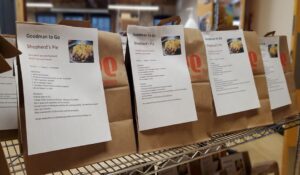How does a food pantry serve 3,000 more people and distribute 113,000 more pounds of food, yet reduce its overall costs by one-third? For Minneapolis-based NorthPoint Health & Wellness Center’s Community Food Shelf, it started with jelly – and a lot of data.
NorthPoint is a choice pantry that regularly purchased jelly so shoppers could make PB&J sandwiches at home. But when it reviewed a Food Sourcing Analysis Report prepared by Minneapolis-based Foundation for Essential Needs, it became clear the cost of all that jelly added up.
“On a week-to-week basis it seems relatively inexpensive,” says Marissa Elliott, NorthPoint’s Director of Outreach and Health Initiatives. “When you zoom out and look at it over a six-month period, suddenly that small choice feels like a big choice. And it’s actually taking up a larger portion of your budget than you had thought.”
There’s more to the story than just jelly, of course. Like many food pantries, NorthPoint operates in a complex environment of increased need and scarce funds. Foundation for Essential Needs created the food sourcing tool to help Minnesota’s food pantries look beyond pounds in/pounds out and shoppers served, to focus instead on the impact of longstanding purchasing habits and the cumulative impact of small purchases. Over time, it has also built a benchmarking tool to help food pantry leaders evaluate their sourcing in a broader context.
“There actually are a lot of choices you have control over in how you build a sourcing strategy,” said Kate Burggraff, Executive Director at Foundation for Essential Needs, which is on track to help 200 food pantries in Minnesota get a handle on their food sourcing this year, up from 150 in 2023.
For Elliott at NorthPoint, the analysis’ biggest surprise was how much NorthPoint was spending per shopper — $11 against a state benchmark of just under $4. “It was great that we were giving people a lot of food,” she said, “but it’s just not sustainable.”
Consulting with Foundation for Essential Needs led NorthPoint to reduce its purchasing, double its food rescue days from three to six (with a focus on meat, dairy and produce), and replace expensive purchases with less expensive versions where possible, without sacrificing quality.
Two years and five cycles of analysis later, NorthPoint is spending just over $6 per shopper – still above the state benchmark, but significant progress. It has increased the amount of food from food rescue to 56%, up from 41%, and boosted the amount of food consisting of produce, protein and dairy to 66%, up from 50%.
Using Minnesota’s 2022 Food Shelf Survey as a model, NorthPoint also surveyed its community to ensure its offerings were aligned with their needs. The survey yielded some surprises, not the least of which was that NorthPoint’s shoppers weren’t interested in PB&Js.
“Actually, for a lot of our shoppers, it wasn’t something that they were even familiar with,” Elliott said, adding, “It’s not just about having food on the shelves for the sake of having food on the shelves. We also have to make sure we’re actually getting people the things that they need.”
Food pantries that undertake Foundation for Essential Needs’ food sourcing analysis on a semi-annual basis commonly reduce costs by 25% to 30%, Buggraff said. The analysis looks at a variety of metrics, such as the amount of pounds sourced by category (produce, protein or dairy) and the method of sourcing (purchased, donated, TEFAP, or rescued), as well as a pantry’s “top spends.”
NorthPoint’s food sourcing analysis led it to make operational changes, including expanded relationships with local grocers (with help from Second Harvest Heartland), a part-time driver to make additional food rescue pickups, and more volunteers to sort through rescued food. The food pantry recently began tracking food waste to better understand the value of what it’s receiving through food rescue. “We have just gotten better all around about what we’re tracking and making sure that what we’re tracking is meaningful,” Elliott said.
Elliott’s experience with the food sourcing analysis has confirmed for her the importance of balancing the strong feelings that often accompany working in food security with data. “That’s really helped us think through why we’re doing things and being very clear on our approach, because once we got clear on our approach, everything else just fell into place.” – Amanda Jaffe
Amanda Jaffe is a writer and former attorney with a deep interest in organizations and mechanisms that address food insecurity. Her online publication, Age of Enlightenment, is available on Substack, and her essays and articles may be found at www.amandajaffewrites.com.
PHOTO, TOP: Marissa Elliott, Director of Outreach and Health Initiatives at the Community Food Shelf of NorthPoint Health & Wellness Center. Photo credit: David Pierini, North News
Like what you’re reading?
Support Food Bank News









